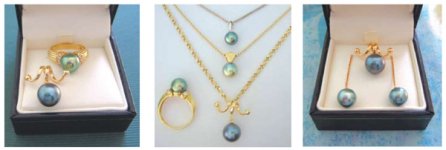SteveM
Well-known member
- Joined
- Jan 29, 2007
- Messages
- 2,026
The July/August/September 2008 issue of Pearl World contains an update on Micronesian pearling by Masahiro Ito, Director, Aquaculture Research and Development, College of Micronesia Land Grant Program.
In 'Cook Islands Pearling Developments' I fostered a largely conjectural discussion of that country?s need to create an image for its P. Margaritifera cultured pearls that would be distinct from that of French Polynesia. The inevitable conclusion was that lip service may be all the Cook Islanders are willing to provide, content in their subservient role.
Micronesia seems to have a better handle on this, focusing on pearls that target the green, blue and golden-green range (current sizes 10-14mm in round). While commercial production is not foreseen until after 2010, government-sponsored hatcheries in support of the nascent industry are being established in order to avoid a repeat of recent farm failures in the Marshall Islands due to inadequate spat supply. Additionally, a locally retired Japanese master grafting technician is passing along his skills to local apprentices.
Considering Cook Islands' challenges resulting from past disasters (natural and otherwise) and local government ineptness, Micronesia is a breath of fresh air. Additionally, Federated States of Micronesia?s free association as a protectorate of the US and friendly foreign investment regulations constitute a healthy business environment.
Hopefully this thread will attract more detailed information and regular updates from locals and trade members in the know.
Thanks to Bo Torrey of Pearl World for his permission to share this photo of jewelry made by Australian and Japanese jewelers using experimental Micronesian cultured pearls.
In 'Cook Islands Pearling Developments' I fostered a largely conjectural discussion of that country?s need to create an image for its P. Margaritifera cultured pearls that would be distinct from that of French Polynesia. The inevitable conclusion was that lip service may be all the Cook Islanders are willing to provide, content in their subservient role.
Micronesia seems to have a better handle on this, focusing on pearls that target the green, blue and golden-green range (current sizes 10-14mm in round). While commercial production is not foreseen until after 2010, government-sponsored hatcheries in support of the nascent industry are being established in order to avoid a repeat of recent farm failures in the Marshall Islands due to inadequate spat supply. Additionally, a locally retired Japanese master grafting technician is passing along his skills to local apprentices.
Considering Cook Islands' challenges resulting from past disasters (natural and otherwise) and local government ineptness, Micronesia is a breath of fresh air. Additionally, Federated States of Micronesia?s free association as a protectorate of the US and friendly foreign investment regulations constitute a healthy business environment.
Hopefully this thread will attract more detailed information and regular updates from locals and trade members in the know.
Thanks to Bo Torrey of Pearl World for his permission to share this photo of jewelry made by Australian and Japanese jewelers using experimental Micronesian cultured pearls.

